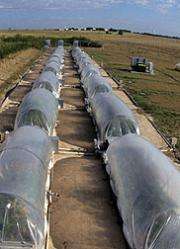Time-Tunneling for Climate Change Clues

(PhysOrg.com) -- If you look closely at individual plant species' responses in the past, you may find that the largest effects of high carbon dioxide (CO2) levels occurred decades ago, according to Agricultural Research Service (ARS) scientists. That is when the botanical structure of the world's grasslands changed dramatically, offering clues to the future.
For several years, Wayne Polley and Philip Fay, ecologists at the ARS Grassland Soil and Water Research Laboratory in Temple, Texas, have been studying plant reactions to a gradient of CO2 levels, from the Ice Age—13,000 to 18,000 B.C.—to the year 2050 A.D. Their research supports the U.S. Department of Agriculture's priority of developing long-range global change strategies.
The ecologists do their research with "time tunnels." These are long, plastic-covered tunnels in which tall prairie grasses are exposed to increasing levels of CO2. These tunnels are an alternative to traditional open-top outdoor chambers in which plants are exposed to only one level of CO2 per chamber.
Among their recent findings is that grasses respond to higher CO2 levels by using water more efficiently. They have been measuring plant water use for four years now, ever since they modified the tunnels by placing them over steel-lined, soil-filled pits with soil-weighing lysimeters to measure soil water loss.
More efficient water use by prairie grasses sounds like a good thing, but weedy shrubs and grasses also benefit from increased water use efficiency. This may help weeds outcompete desirable forage plants. But the cumulative effects of these individual species' responses on plant communities won't be obvious for years.
Read more about this and other climate change research in the November/December 2009 issue of Agricultural Research magazine.
Provided by USDA Agricultural Research Service




















